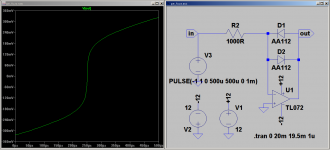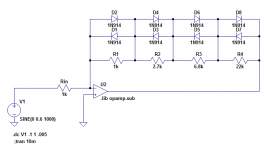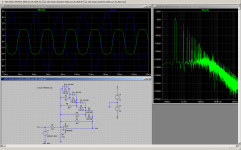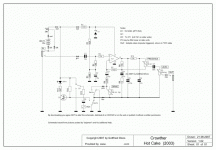I did not simulate, I did a breadboard test with 2 antiparallel Ge-Diodes. Some AA112 if memory serves me - but this is long time ago. At that time I had no access to circuit diagrams of commercial fuzz boxes.
What happens if you increase the value of R2, R5, and R6? Looks like you would need less output current from the op-amp to turn on the transistors?...you need a beefy opamp...as it must be able to drive 10mA output current easily to 10V
-Gnobuddy
This particular circuit is analytically tractable - the current through a diode is a nearly perfect exponential of the applied voltage; when the diode is driven with a constant current instead, as in this circuit, it has the inverse response: the output voltage is the natural logarithm of the current, which in turn is directly proportional to the input voltage.I did a quick and dirty sim of AA112 fuzz. With a triangle input signal the output of a half wave equals the transfer curve.
To be a little more exact, the output voltage of this circuit is directly proportional to the logarithm of the absolute value of the input signal (because the second diode takes over when the input changes sign.)
Before there were digital computers, this circuit used to be used in analog computers - to calculate the logarithm of the input signal! (There were later improvements to reduce temperature coefficient, and widen the range of inputs for which the output is an accurate logarithm.)
-Gnobuddy
Voltwide's sim is a classic, I recall it as the my first working opamp circuit back when I was a kid and needed more distortion that what could be had from an old tube radio I used to use as amplifier.
While the transfer is smoother than with silcon diodes there are drawbacks. Output voltage is very limited, it's noisy, gain at low input level voltages is determined by ill defined leakage currents and while paralleling a resistor is fine to stabilize the gain it decreases gain significantly. To get more gain to begin with we could scale down the input R (the gain is R_leak/R_in) but then we see another problem popping up: the intrinsic forward path resistance which is higher than with silicon which linearizes the voltage because the current starts to get dominated by this resistance once it is higher than the "true" junction resistance for a given current, the diode becomes more and more a simple resistor.
Of course, given the simplicity of the circuit it's hard to beat.
While the transfer is smoother than with silcon diodes there are drawbacks. Output voltage is very limited, it's noisy, gain at low input level voltages is determined by ill defined leakage currents and while paralleling a resistor is fine to stabilize the gain it decreases gain significantly. To get more gain to begin with we could scale down the input R (the gain is R_leak/R_in) but then we see another problem popping up: the intrinsic forward path resistance which is higher than with silicon which linearizes the voltage because the current starts to get dominated by this resistance once it is higher than the "true" junction resistance for a given current, the diode becomes more and more a simple resistor.
Of course, given the simplicity of the circuit it's hard to beat.
While the transfer is smoother than with silcon diodes there are drawbacks. Output voltage is very limited, it's noisy, gain at low input level voltages is determined by ill defined leakage currents and while paralleling a resistor is fine to stabilize the gain it decreases gain significantly. To get more gain to begin with we could scale down the input R (the gain is R_leak/R_in) but then we see another problem popping up: the intrinsic forward path resistance which is higher than with silicon which linearizes the voltage because the current starts to get dominated by this resistance once it is higher than the "true" junction resistance for a given current, the diode becomes more and more a simple resistor.
Of course, given the simplicity of the circuit it's hard to beat.
The drawback could be "overcomed" by inserting Si-Diode in series and same direction to each Ge-Diode. By doing this I have got a very nice distortion character that smoothly "cleans out" to undistorted sound, without the nasty sounding leakage currents from Ge-Diodes.
Is that a Gibson through a Marshall?
What do You mean? Guitar is Ibanez, but the point is solidstate clipping circuit here.
Here is another well known clipping circuit and sound sample.
I have made only 3 diode stages, that's enough for guitar. Values are:
R4=47k
R3=15k
R2 = 2.2k
R1||D1||D2 are omitted.
Rin 2.2k is driven by another non-inverting Opamp with gain 22x. Distorion/overdrive is controlled only by guitars "volume" knob.
I have made only 3 diode stages, that's enough for guitar. Values are:
R4=47k
R3=15k
R2 = 2.2k
R1||D1||D2 are omitted.
Rin 2.2k is driven by another non-inverting Opamp with gain 22x. Distorion/overdrive is controlled only by guitars "volume" knob.
Attachments
Last edited:
Thanks for sharing!I have made only 3 diode stages, that's enough for guitar.
Years ago I had a similar idea, but I arranged the diodes to switch additional resistances in parallel, rather than bypassing more and more resistors that are in series. I would think the same transfer function (Vo/Vi) should be possible with either circuit (but using different resistor values, obviously.)
The FFT shows higher harmonics trailing off in level quite rapidly, and even overdriven to this extent, only 2nd, 3rd, and 4th harmonics break into the top 40 dB of signal dynamic range. Harsh-sounding higher harmonics are quite weak.
It has been a very long time since I built the circuit (1990s), and I was not much of a guitar player back then, so I can't really tell you how it sounds. Consider it a starting point for some experimentation.
As with Guitar.mod's circuit, this will want a buffer stage with gain ahead of it, and probably some frequency shaping to keep it from sounding dull and muddy.
I used an NE5532 in the LTSpice simulation, but a TL072 with its JFET input stage might be a better choice for this particular application.
-Gnobuddy
Attachments
Gnobuddy, That looks like a cool idea and some pretty smooth clipping. I will give this a try. I might use different diodes for the up and down cycles to get some asymmetrical clipping.
Do let us know how your variation turns out!I will give this a try.
My memory is that the one I built worked best as a fairly subtle overdrive.
As I mentioned, I wasn't much of a player back then. Also I didn't realize that cutting bass before overdriving usually produces a more attractive and less muddy sound.
-Gnobuddy
the best clipping circuit i've ever heard and played into is:
the ProCo Rat Turbo
with the clipping diodes pair removed/pulled out/no diodes
the Op-Amp must be lm308n and no other
the 30pf compensation cap must be increased to taste
usually the rat signal passes to a pair of diodes in the end of the signal chain, this is a total waste of dynamics and feel... the diodes shunt to the ground the cut signal, its such a crime...
the fulltone ocd have a smarter approach: they shunt the clipped signal back to the op-amp vcc, of which is an improvement
but its hard to beat a turbo rat with lm308n and no diodes, because the op-amp is very sensitive (designed for both seismic and medical devices) so the 308n clips with dynamic even at low gain settings, but its a very pleasant way
on tougher settings, theres harsh treble fizz, so a larger compensation cap is highly desireable, such as 100pf or so
some say any chip with a low slew rate will do, such as a op07, but i say it must be the lm308n
it have a better clipping, the higher octaves wont fry out your ears due to limited bandwith, and the filter control works optimal with the lm308n... for example the op07 gets dulled out and lifeless with filter control maxed... on the lm308n it only filters the fizz...
try for yourselves the ProCo Rat Turbo with lm308n and no clipping
diodes
some might say the main difference between rat models (r2/tr/ydr) is the clipping diodes (si/led/ge)
but theres more into it
the turbo rat came stock with higher tolerances for example... you can series 2x 9v carbon batts and make it run 18v for pure mayhem!
lm308n sensitive op-amp clipping is the way to go, if you want overdrive headroom go for tubes!!!
my 5 brazilian cents, they are worth less than 2 cents in usd!
the ProCo Rat Turbo
with the clipping diodes pair removed/pulled out/no diodes
the Op-Amp must be lm308n and no other
the 30pf compensation cap must be increased to taste
usually the rat signal passes to a pair of diodes in the end of the signal chain, this is a total waste of dynamics and feel... the diodes shunt to the ground the cut signal, its such a crime...
the fulltone ocd have a smarter approach: they shunt the clipped signal back to the op-amp vcc, of which is an improvement
but its hard to beat a turbo rat with lm308n and no diodes, because the op-amp is very sensitive (designed for both seismic and medical devices) so the 308n clips with dynamic even at low gain settings, but its a very pleasant way
on tougher settings, theres harsh treble fizz, so a larger compensation cap is highly desireable, such as 100pf or so
some say any chip with a low slew rate will do, such as a op07, but i say it must be the lm308n
it have a better clipping, the higher octaves wont fry out your ears due to limited bandwith, and the filter control works optimal with the lm308n... for example the op07 gets dulled out and lifeless with filter control maxed... on the lm308n it only filters the fizz...
try for yourselves the ProCo Rat Turbo with lm308n and no clipping
diodes
some might say the main difference between rat models (r2/tr/ydr) is the clipping diodes (si/led/ge)
but theres more into it
the turbo rat came stock with higher tolerances for example... you can series 2x 9v carbon batts and make it run 18v for pure mayhem!
lm308n sensitive op-amp clipping is the way to go, if you want overdrive headroom go for tubes!!!
my 5 brazilian cents, they are worth less than 2 cents in usd!
Interesting. This will drive the input of the guitar amp really hard, even before the op-amp itself begins to clip, and cause a lot more distortion in the input of the guitar amp.ProCo Rat Turbo...clipping diodes pair removed/pulled out/no diodes
Also, as you said, once the op-amp itself does start to clip, it is going to be very hard, fizzy, and abrupt clipping. Not to everybody's taste.
The OCD uses a pair of resistors to split the 9V supply and produce a sort of fake ground rail at +4.5 volts. From the point of view of the guitar signal, returning the clipped signal to this point is actually exactly the same as returning it to ground.the fulltone ocd have a smarter approach: they shunt the clipped signal back to the op-amp vcc, of which is an improvement
But the OCD uses a pair of MOSFETs to clip the signal, instead of a pair of silicon diodes. That, and minor variations in the EQ / voicing, probably accounts for any differences in sound quality.
Full disclosure, I haven't used either of these pedals. Most of the time, when I try a distortion pedal, I quickly come to the conclusion that the guitar sounds better without it! 🙂
-Gnobuddy
Interesting. This will drive the input of the guitar amp really hard, even before the op-amp itself begins to clip, and cause a lot more distortion in the input of the guitar amp.
yeah, the slight boost can help slam the front end of the amp, but if the headroom of the front end is massive, there'd be a mix of signal boost with slight, very little breakup/clipping
Also, as you said, once the op-amp itself does start to clip, it is going to be very hard, fizzy, and abrupt clipping. Not to everybody's taste.
yes, but the rat with lm308n have a special behaviour, even with little gain at the pedal input, theres a chance to induce op-amp clipping if the guitar is loaded with heavy gauges and a strong pickup...
when the input gain gets enough, it gets fizzy as you confirmed, but not the way we are used to expect from another op-amps... it's worth experimenting, not trying to advertise this product... just saying lol
The OCD uses a pair of resistors to split the 9V supply and produce a sort of fake ground rail at +4.5 volts. From the point of view of the guitar signal, returning the clipped signal to this point is actually exactly the same as returning it to ground.
thanks for the input, i didn't know this deep about the OCD... now it makes sense why it sucked when i've tried to do this with the turbo rat before realizing that it was easier to pull the clipping leds out and call it a day
But the OCD uses a pair of MOSFETs to clip the signal, instead of a pair of silicon diodes. That, and minor variations in the EQ / voicing, probably accounts for any differences in sound quality.
i did consider throwin' in da TR this clipping in the past, i recall its something 007 or 700 something the model of the mosfet, but i hadn't these laying around and i was too lazy to go downtown buy some, so it stayed in the 'someday' list
Full disclosure, I haven't used either of these pedals. Most of the time, when I try a distortion pedal, I quickly come to the conclusion that the guitar sounds better without it! 🙂
yah, i know how does it feel to be misadjusted into the dirt stompboxes...
the bottle rocket thingy got an improvement, but had no true bypass and it ruined the dry signal
the rat will never sound and feel like a true tube amp at the edge of exploding the room, although its a modest mouse to get the job done when nothing else fills in
today i've had a nice time with the blackstar ht-dual, its warmer than the rat, but it must be always turned on, otherwise the buffered bypass will color the dry signal, so its a dillema
i think the best solution for me is to remove the 15/7w pentode/triode switch in my amp, keep it fixed at 15w/pentode and install a jack where the switch was, to engage a footswitch that adds extra resistance from a variable resistor to ground in the mids, pre gain pots to behave like a second, drive channel, but i feel somewhat relutant to create a new topic about it since i've made so much questions and i do not know if its gonna be respectful to everyone by bombarding this forums with questions looking for a magic formula like a leech, without helping to pay for the advices
by the way, i can contribute with an advice to make the amp more friendly to gain pedals and get the sound somewhat closer to purity...
if we set higher the input resistance to ground, then biasing the plate of v1 with 68k and cathode 850r or 1k, unbypassed by capacitor, then removing the power tube's bypass cap if the tube is bright enough, cathode biased, such as el84 and pull out some preamp attenuators such as series resistors and resistors to ground after tonestack, then there is little output loss, if any loss at all, but alot of headroom
maybe the magic of dirt pedals is to send to the amp a distorted signal, since many of them are recommended to be run into a clean amp
but amps must be sounding great at raw settings to be played first, then we can worry about including pedals/ more gain later
this is the main challenge then, because if we run a tube amp 'cold' with alot of signal going to the ground to keep it clean, then it wont sound nice and not worthy of receiving effects/more gain into the input
so by biasing the amp the way i've stated (unbypassed cathodes, low plate resistors) we get a lil extra headroom and the signal keeps coming in hot, if theres loss in volume, just get rid of some attenuators in the signal path
it might sound silly and i have little of technical knowledge to back it up, but i swear that i did it to my gear and there was audible improvement, i can record samples, but maybe its easier to take some day to just do it and 'see' how does it feel
hope it helps
lets get dirtier, everybody *laughs*
OMG!! pLaSm@ distortion WTF?!?!
true plasma bolts inside xenon filled tube
wtf
i want one... too bad i cant afford it + shipping bureoucracy
is it hard to DIY?!
PLASMA PEDAL ⋆ Gamechanger Audio
true plasma bolts inside xenon filled tube
wtf
i want one... too bad i cant afford it + shipping bureoucracy
is it hard to DIY?!
PLASMA PEDAL ⋆ Gamechanger Audio
the best clipping circuit i've ever heard and played into is:
with the clipping diodes pair removed/pulled out/no diodes
the Op-Amp must be lm308n and no other
but its hard to beat a turbo rat with lm308n and no diodes, because the op-amp is very sensitive (designed for both seismic and medical devices) so the 308n clips with dynamic even at low gain settings, but its a very pleasant way
on tougher settings, theres harsh treble fizz, so a larger compensation cap is highly desireable, such as 100pf or so
some say any chip with a low slew rate will do, such as a op07, but i say it must be the lm308n
it have a better clipping, the higher octaves wont fry out your ears due to limited bandwith, and the filter control works optimal with the lm308n... for example the op07 gets dulled out and lifeless with filter control maxed... on the lm308n it only filters the fizz...
Thank You for the input!
If You want to have a good sound from heavily overdriven opamp, without "harsh treble fizz" (without any other clipping circuits), you need to use another circuit. Here is attached "Hot Cake" circuit as an example. It sounds very good and cleans out nicely even from very hard overdrive.
p.s. If we overcompensate LM308 (with 100p compensation cap) we will get almost the same slew rate as OP07. OP07 has much lower equivalent input noise - that is very useful at high gain settings.
Attachments
- Status
- Not open for further replies.
- Home
- Live Sound
- Instruments and Amps
- show your creative clipping circuits



